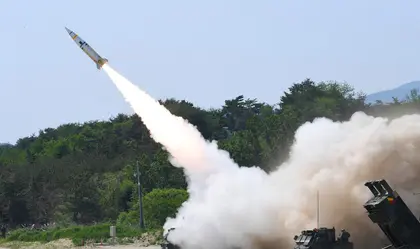Ukraine’s Armed Forces (AFU) launched a mass long-range missile strike on Monday evening that saturated a Russian military base deep behind the front lines with cluster munitions initiating a blaze, that could be seen and heard dozens of kilometers away, along with hundreds of smaller fires.
The target reportedly consisted of buildings and an adjacent airfield on the territory of the former Ukrainian air force navigation academy in the eastern city Luhansk. The site had been occupied by Moscow’s troops who used a headquarters and logistics base following Russia’s first invasion of Ukraine in 2014.
JOIN US ON TELEGRAM
Follow our coverage of the war on the @Kyivpost_official.
An aircraft repair and maintenance facility used by Russian forces is located a few hundred meters away from the airfield, and also was targeted, some reports said.
Dozens of video and still photographs posted to social media – in violation of Russian law which bans such action – showed flames reaching dozens of meters into the night sky from the vicinity of the airfield around 7 p.m. local time, and also images taken from the ground showed hundreds of square meters of landing strip saturated with fires.
There were no early reports of damage or casualties.
Both the Russian state-controlled official information agency TASS and independent Ukrainian news platforms confirmed the area of the airfield had been hit by dozens of explosions and then consumed by multiple fires. The Ukrainian news agency UNIAN said the strikes set off “a massive blaze.”

Ukraine Modifies Domestic UAV Into FPV Strike Drone ‘Aircraft Carrier’
Local sources said Russian air defenses fired on the incoming weapons but failed to stop many. The local Trukha Lugansk chat group published images of the booster stage of a Pantsyr S-1 anti-aircraft missile, a close-in air protection weapon for the defense of high-value targets from aircraft attack, on May 28. The report said that the Pantsyr missile missed an incoming Ukrainian missile and landed in a courtyard, harming no one and causing no property damage.

Leonid Pasechnik, an official in the pro-Russian Luhansk occupation authority, said Kyiv forces had used UN-banned cluster munitions in the attack. Local early warning Telegram networks in the first minutes of the strike said the Ukrainians launched the attack from the vicinity of the city of Kramatorsk, some 135-140 kilometers east of the airfield.
According to open sources, Ukraine only fields two major weapons systems capable of delivering cluster munitions at that range – the US-made ATACMS missile and the Soviet-era Tochka-U missile. Both Russian and Ukrainian social media widely identified the strike weapon as being ATACMS, though there has so far been no official confirmation.
Following a four-month total halt to US arms deliveries because of Congressional infighting, Ukraine received renewed transfers of ATACMS missiles in late April. The end of the US embargo has seen Kyiv energetically launching ATACMS against nine formerly out-of-range Russian targets in the occupied Crimea region including Russian air force bases and aircraft, Russian navy warships, and high-tech Russian anti-missile systems as well as used ATACMS to hit a Luhansk oil refinery twice.
A ballistic missile flying in a high trajectory close before plunging at its target at near hypersonic-speeds, the ATACMS is a key piece of the US ground-based high tech combat capacity. According to open-source reports, the ATACMS missile Washington is currently delivering to Kyiv are most likely 1990s builds with shorter range and less ability to dodge interception than the most modern models.
The two US-made platforms firing that missile, the HIMARS wheeled system and the M270 tracked system, were originally designed to fire barrages of the smaller and cheaper guided M42 122mm rocket rather than the bulky and costly 610mm ATACMS missiles as single individual shots.
HIMARS can fire six M42s in a salvo and the M270 can fire twelve. Ukraine first received M42 rockets in October 2022 and used them for more than a year with good effect, but their maximum 80-kilometer range along with improved Russian jamming has reportedly made the M42 almost ineffective against current Russian defenses.
An experimental 122mm M270/HIMARS EW-resitant missile was test fired by Pentagon contractors in 2023, however, its deployment or use in combat is unconfirmed.
The first use by Ukrainian forces of ATACMS missiles took place on Oct. 17 2023, in strikes against an airfield near the southern city Berdiansk, and the Luhansk airfield that was hit again on Monday. The 2023 attack against the Luhansk air base caught at least two squadrons of Russian helicopters on the ground, destroying at least six as subsequent satellite images showed.
You can also highlight the text and press Ctrl + Enter






